Abstract
Binding of immune complexes (IC) to erythrocytes in vitro is the result of interaction between C3b sites on the IC, and complement receptors type I (CRI) expressed on primate erythrocytes. Recent evidence indicates that primate erythrocytes can also rapidly bind large, preformed IC in vivo. This study was undertaken to determine if the binding of IC to baboon erythrocytes in vivo is complement dependent and to examine the effect of complement depletion on IC clearance from the circulation. The results indicate that complement depletion in vivo reduced the binding of IC to erythrocytes. There was relatively little binding of IC to leukocytes in both the complement-depleted and complement-repleted condition. Thus, the majority of IC not bound to erythrocytes remained free in the plasma and, consequently, IC infusion during the complement-depleted state resulted in increased plasma IC concentrations. This was associated with a rapid disappearance of IC from the circulation. By contrast, in the normal or complement-repleted state, a large fraction of the IC became bound to erythrocytes during IC infusion, which resulted in lower plasma IC concentrations. Under these conditions, a more gradual rate of disappearance of IC from the circulation was observed. The relatively abrupt clearance of IC from the circulation in the complement-depleted state could not be accounted for by increased hepatic or splenic uptake. These data indicate that, in contrast to previous studies in nonprimates, complement depletion in primates results in accelerated removal of IC from the circulation. This suggests that factors such as hypocomplementemia and deficient expression of erythrocyte CRI, which are known to occur in certain IC-mediated diseases, may promote IC uptake by organs vulnerable to IC-mediated injury.
Full text
PDF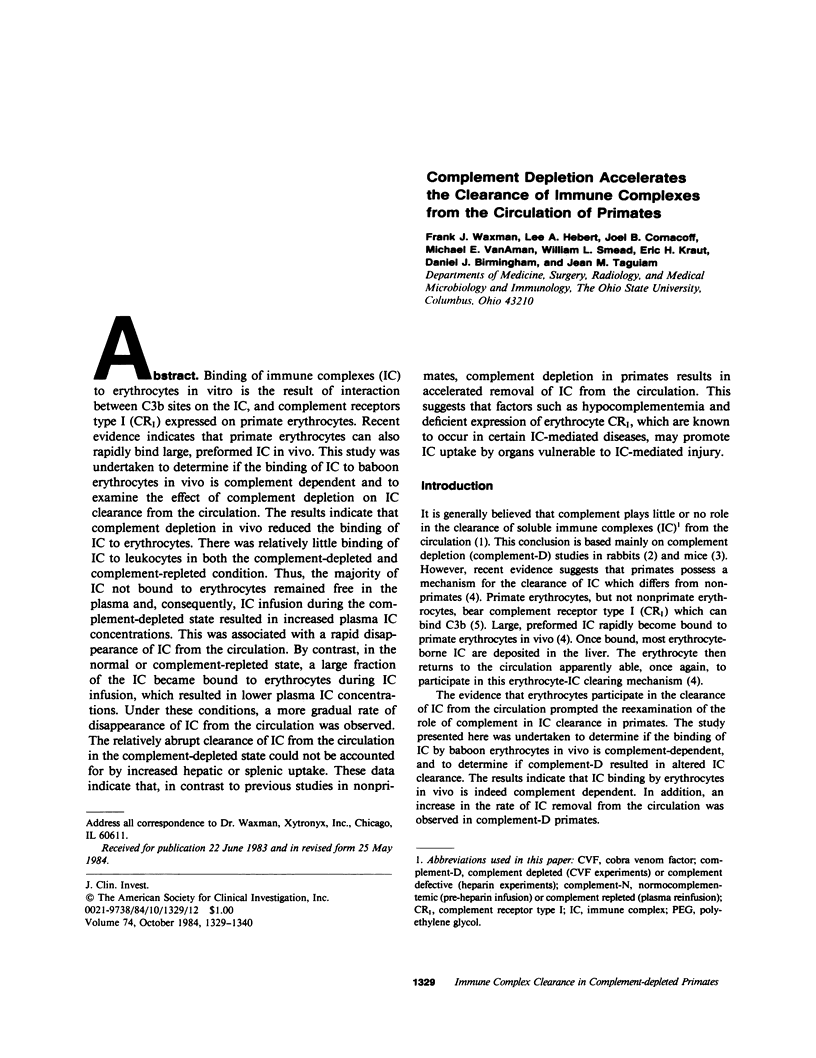
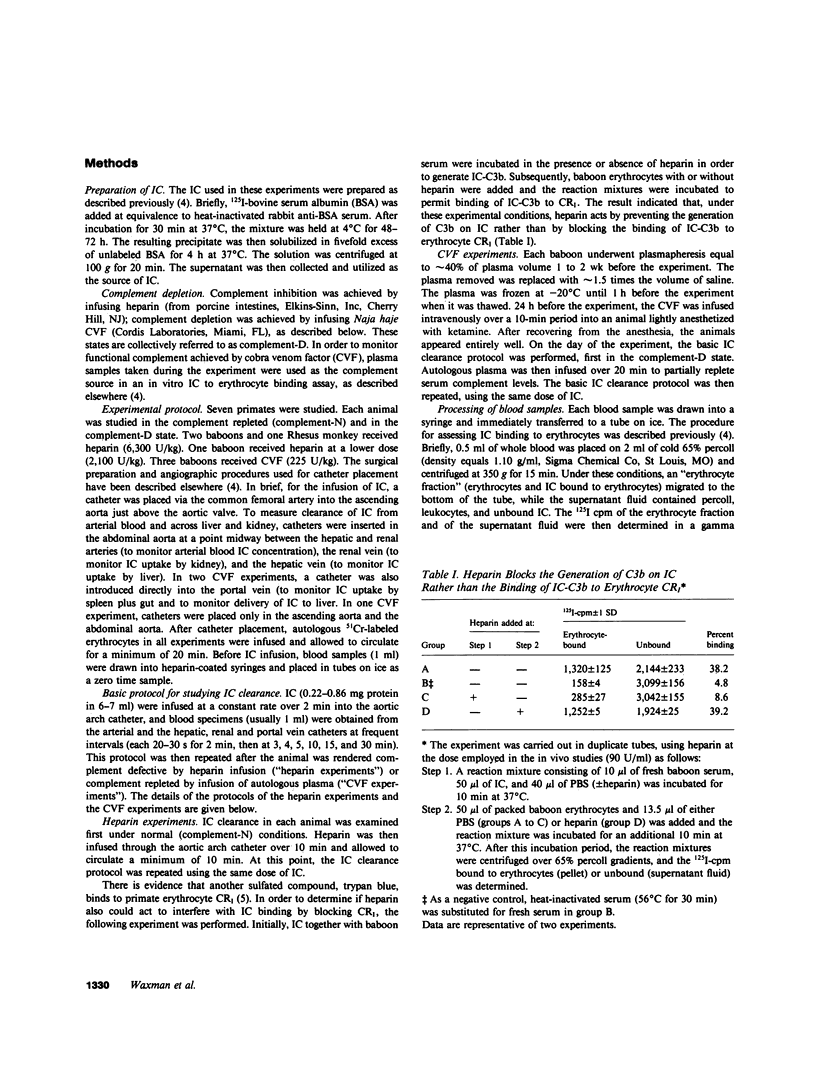
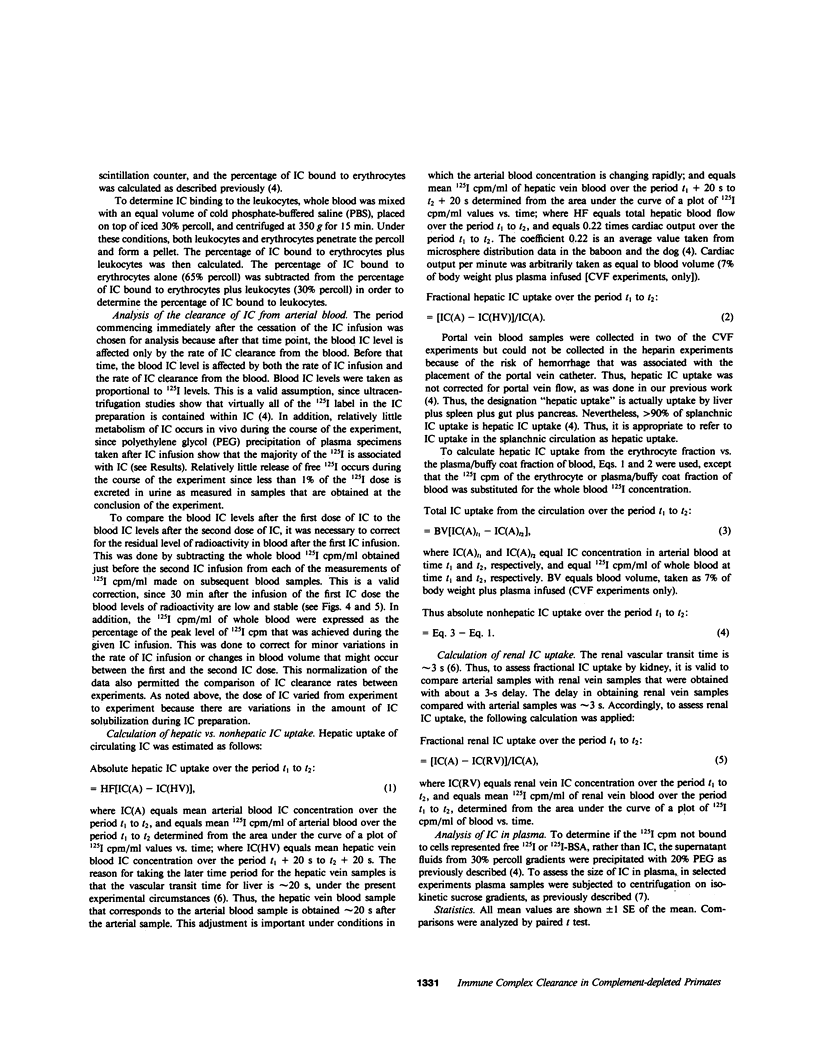
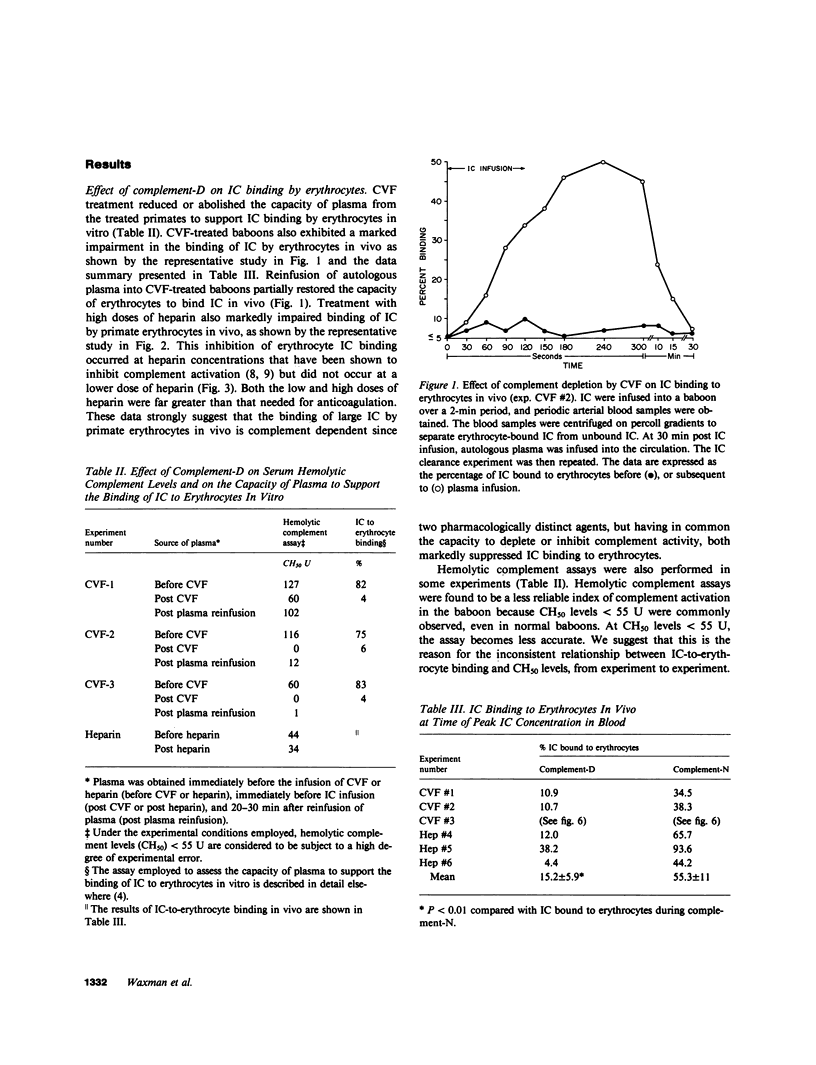
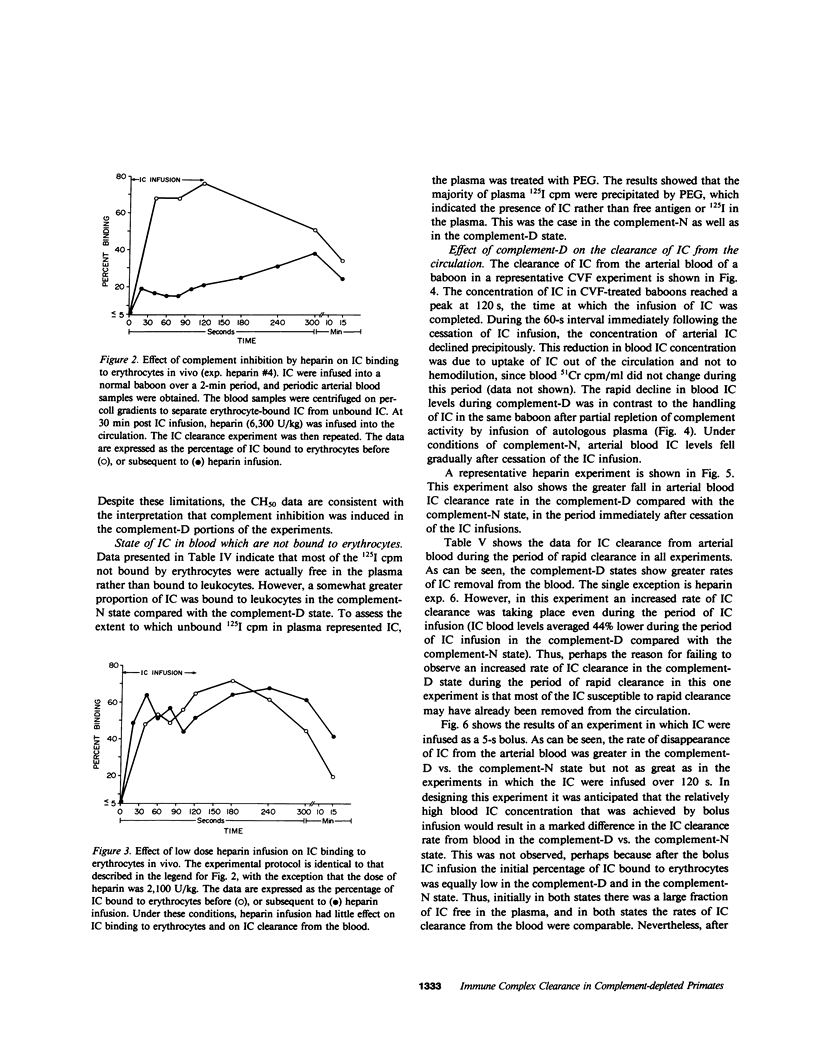
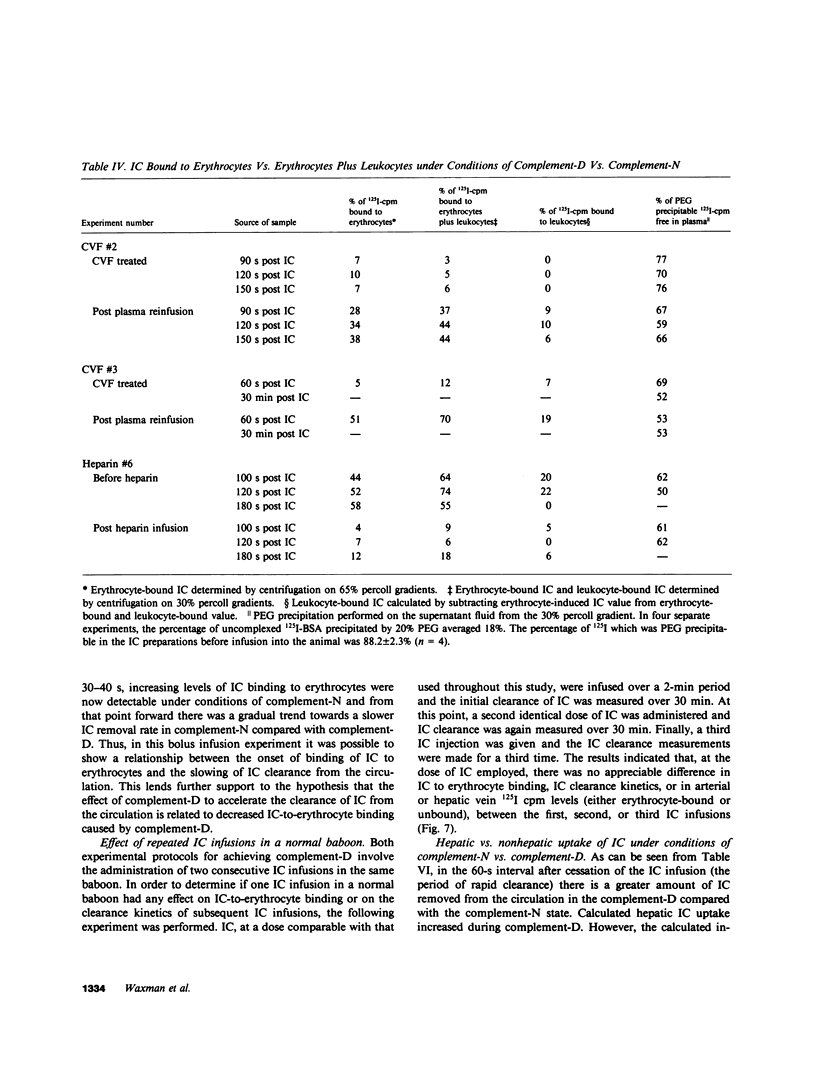
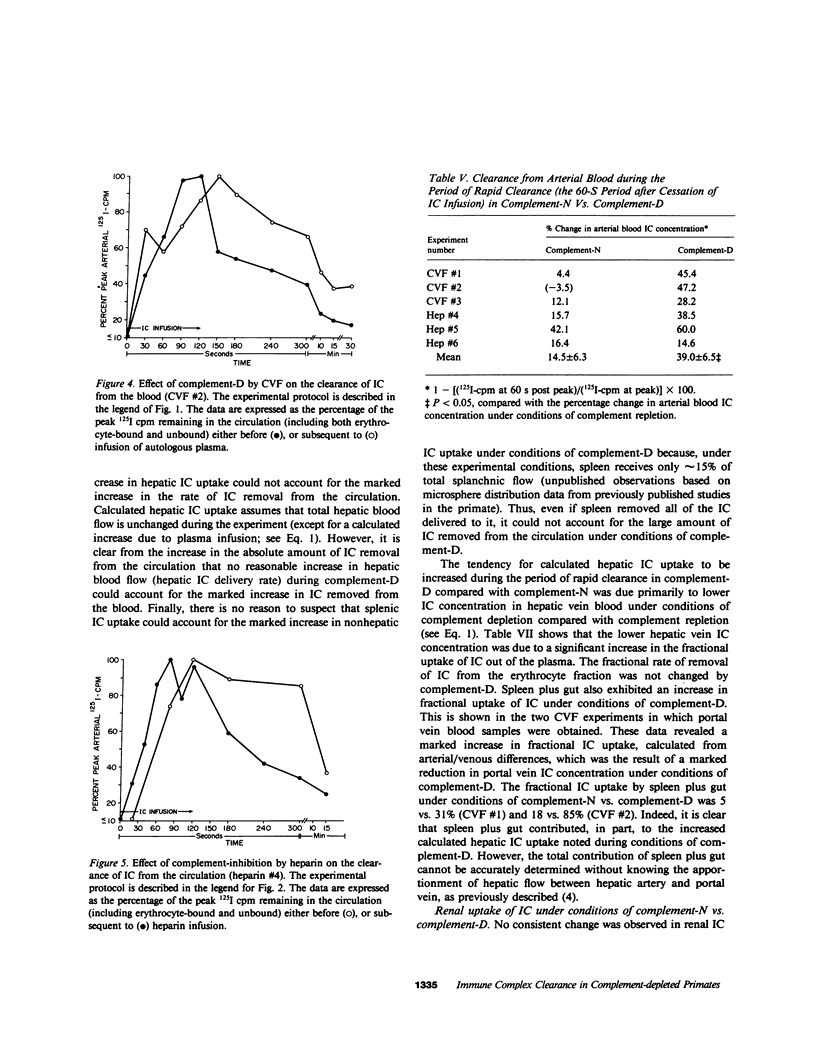
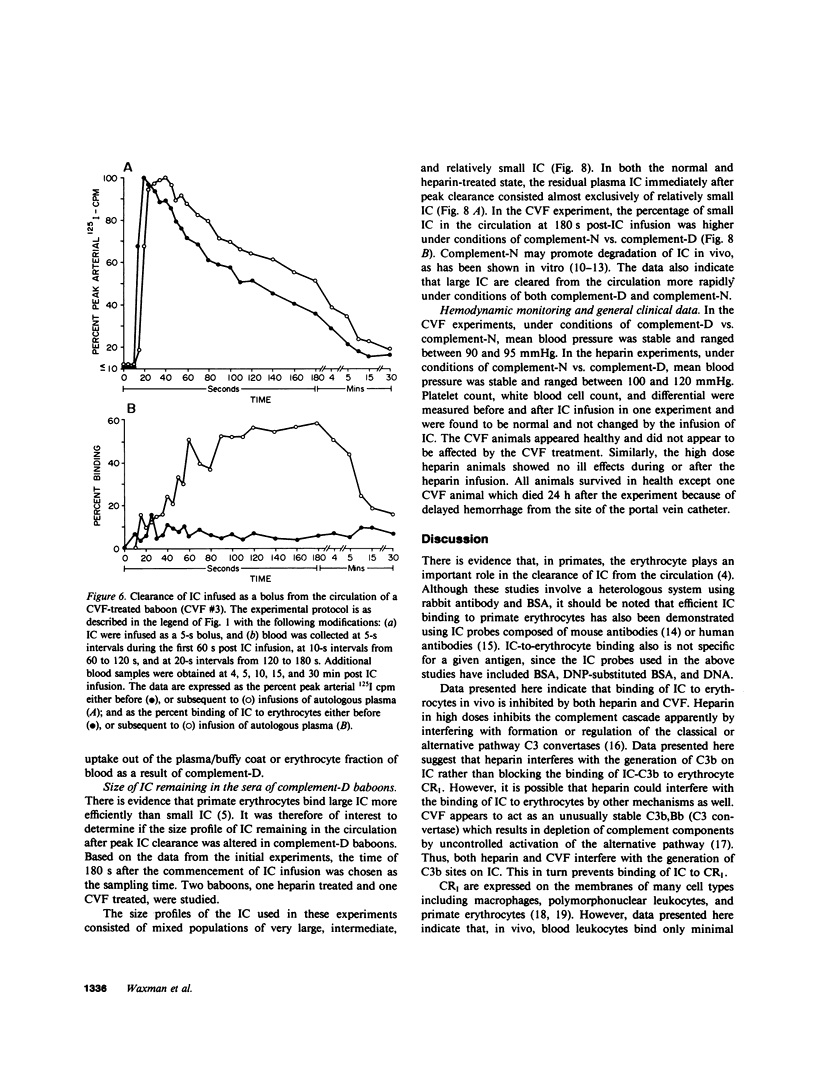
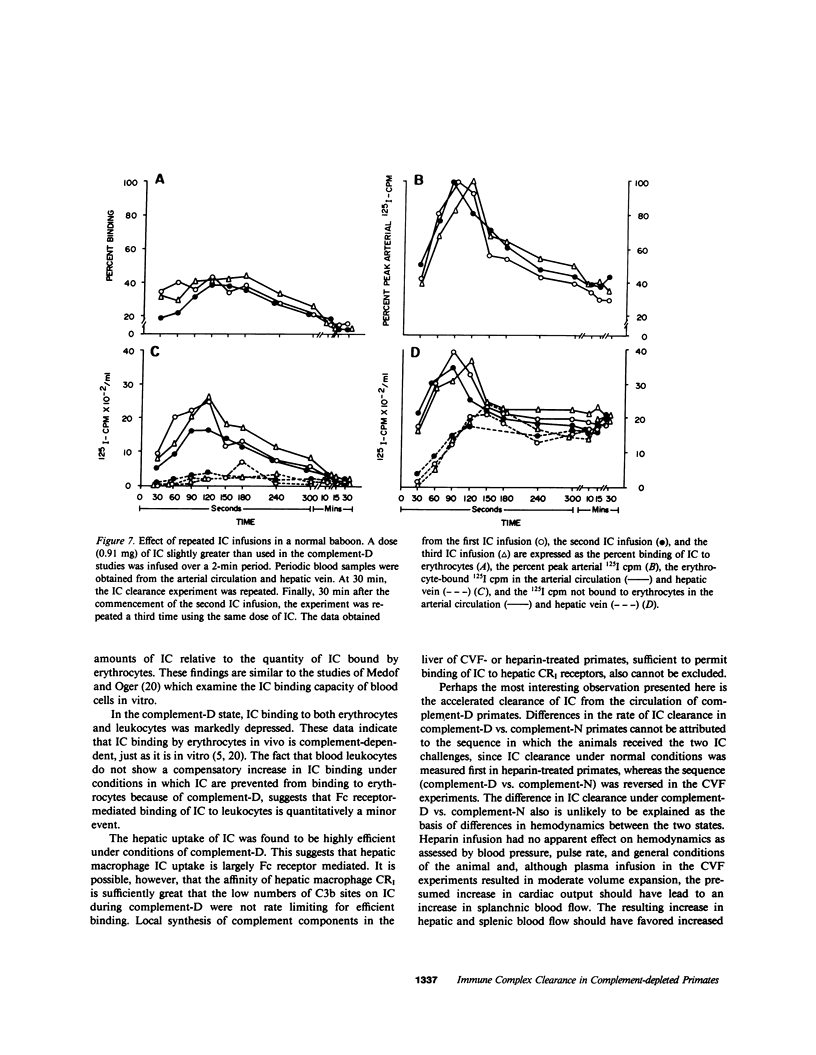
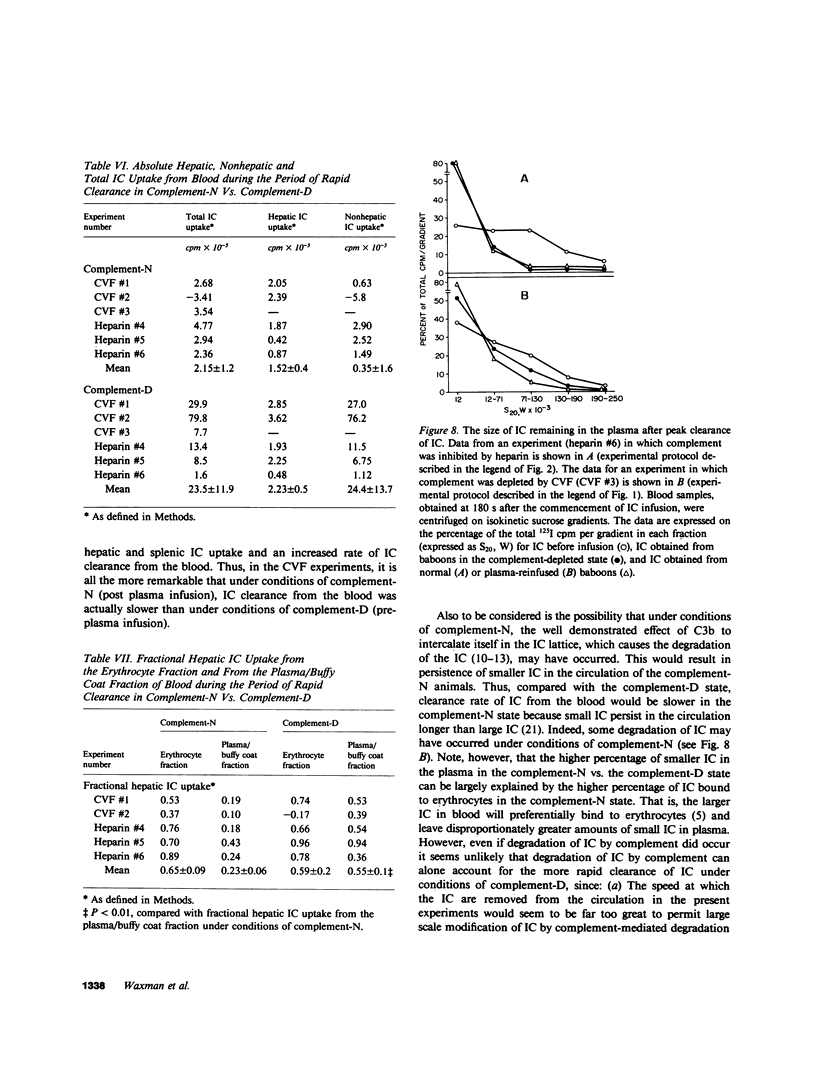
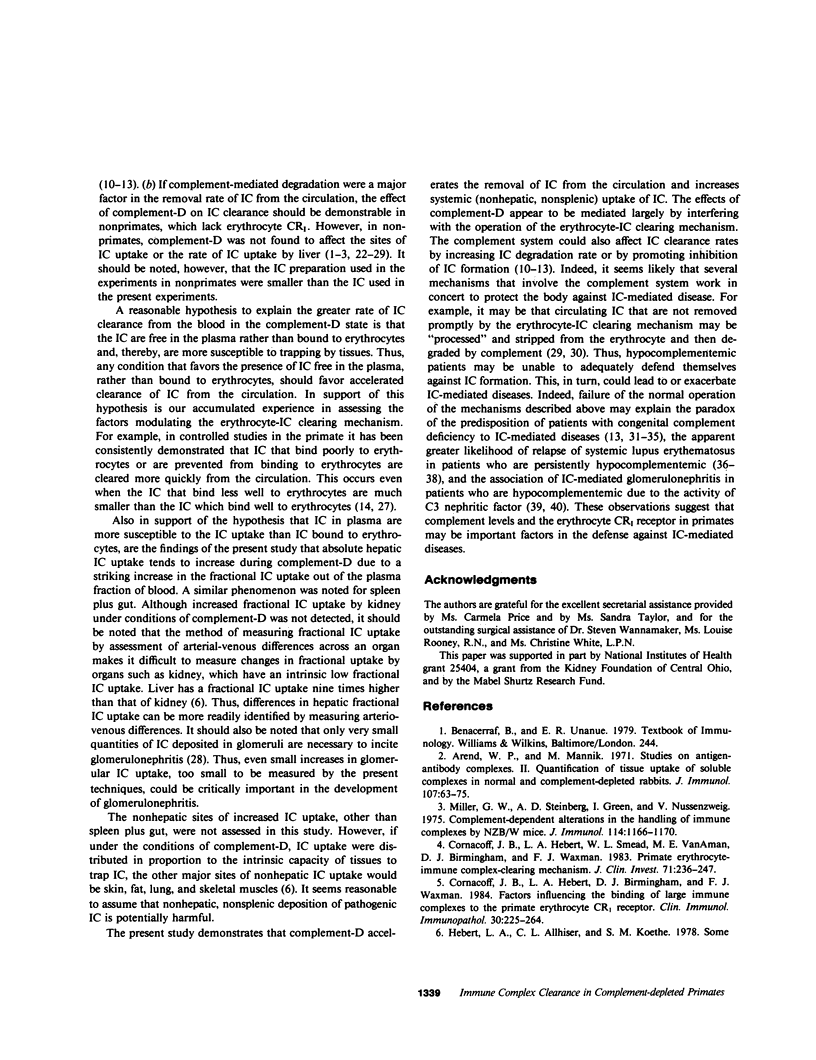
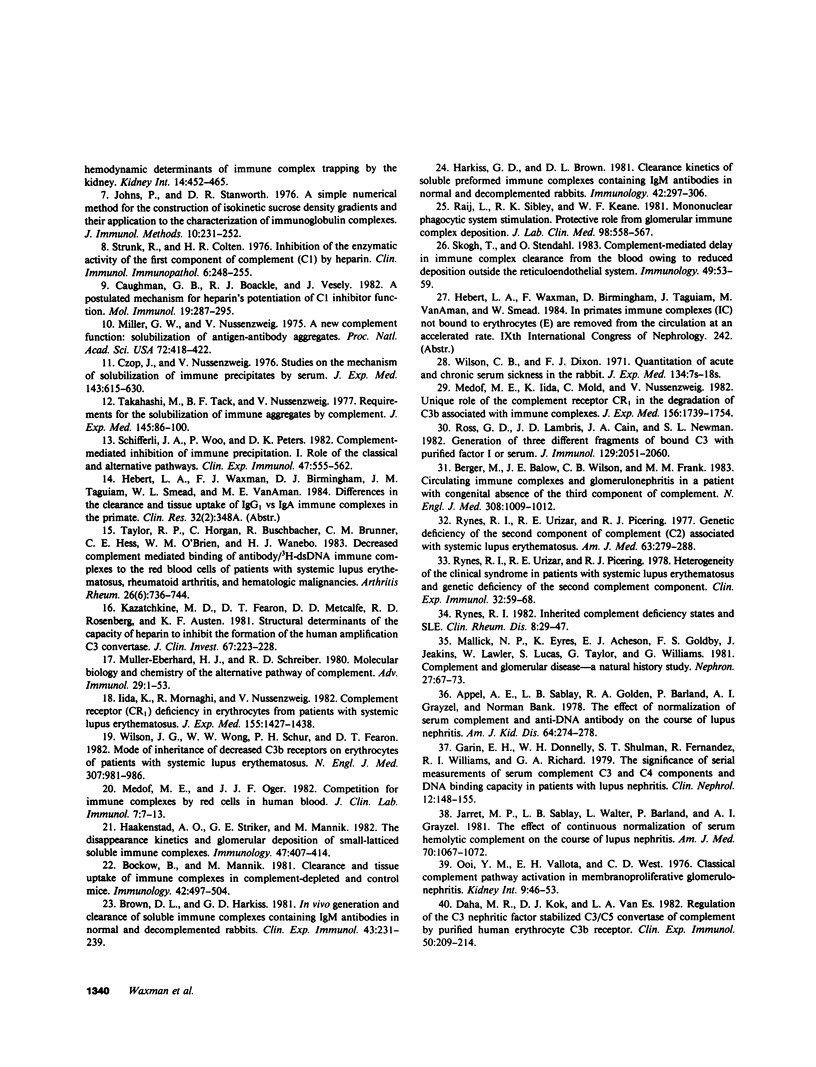
Selected References
These references are in PubMed. This may not be the complete list of references from this article.
- Appel A. E., Sablay L. B., Golden R. A., Barland P., Grayzel A. I., Bank N. The effect of normalization of serum complement and anti-DNA antibody on the course of lupus nephritis: a two year prospective study. Am J Med. 1978 Feb;64(2):274–283. doi: 10.1016/0002-9343(78)90056-6. [DOI] [PubMed] [Google Scholar]
- Arend W. P., Mannik M. Studies on antigen-antibody complexes. II. Quantification of tissue uptake of soluble complexes in normal and complement-depleted rabbits. J Immunol. 1971 Jul;107(1):63–75. [PubMed] [Google Scholar]
- Berger M., Balow J. E., Wilson C. B., Frank M. M. Circulating immune complexes and glomerulonephritis in a patient with congenital absence of the third component of complement. N Engl J Med. 1983 Apr 28;308(17):1009–1012. doi: 10.1056/NEJM198304283081706. [DOI] [PubMed] [Google Scholar]
- Bockow B., Mannik M. Clearance and tissue uptake of immune complexes in complement-depleted and control mice. Immunology. 1981 Apr;42(4):497–504. [PMC free article] [PubMed] [Google Scholar]
- Brown D. L., Harkiss G. D. In vivo generation and clearance of soluble immune complexes containing IgM antibodies in normal and decomplemented rabbits. Clin Exp Immunol. 1981 Feb;43(2):231–239. [PMC free article] [PubMed] [Google Scholar]
- Caughman G. B., Boackle R. J., Vesely J. A postulated mechanism for heparin's potentiation of C1 inhibitor function. Mol Immunol. 1982 Feb;19(2):287–295. doi: 10.1016/0161-5890(82)90342-x. [DOI] [PubMed] [Google Scholar]
- Cornacoff J. B., Hebert L. A., Birmingham D. J., Waxman F. J. Factors influencing the binding of large immune complexes to the primate erythrocyte CR1 receptor. Clin Immunol Immunopathol. 1984 Feb;30(2):255–264. doi: 10.1016/0090-1229(84)90060-6. [DOI] [PubMed] [Google Scholar]
- Cornacoff J. B., Hebert L. A., Smead W. L., VanAman M. E., Birmingham D. J., Waxman F. J. Primate erythrocyte-immune complex-clearing mechanism. J Clin Invest. 1983 Feb;71(2):236–247. doi: 10.1172/JCI110764. [DOI] [PMC free article] [PubMed] [Google Scholar]
- Czop J., Nussenzweig V. Studies on the mechanism of solubilization of immune precipitates by serum. J Exp Med. 1976 Mar 1;143(3):615–630. doi: 10.1084/jem.143.3.615. [DOI] [PMC free article] [PubMed] [Google Scholar]
- Daha M. R., Kok D. J., Van Es L. A. Regulation of the C3 nephritic factor stabilized C3/C5 convertase of complement by purified human erythrocyte C3b receptor. Clin Exp Immunol. 1982 Oct;50(1):209–214. [PMC free article] [PubMed] [Google Scholar]
- Garin E. H., Donnelly W. H., Shulman S. T., Fernandez R., Finton C., Williams R. L., Richard G. A. The significance of serial measurements of serum complement C3 and C4 components and DNA binding capacity in patients with lupus nephritis. Clin Nephrol. 1979 Oct;12(4):148–155. [PubMed] [Google Scholar]
- Haakenstad A. O., Striker G. E., Mannik M. The disappearance kinetics and glomerular deposition of small-latticed soluble immune complexes. Immunology. 1982 Nov;47(3):407–414. [PMC free article] [PubMed] [Google Scholar]
- Harkiss G. D., Brown D. L. Clearance kinetics of soluble pre-formed immune complexes containing IgM antibodies in normal and decomplemented rabbits. Immunology. 1981 Feb;42(2):297–306. [PMC free article] [PubMed] [Google Scholar]
- Hebert L. A., Allhiser C. L., Koethe S. M. Some hemodynamic determinants of immune complex trapping by the kidney. Kidney Int. 1978 Nov;14(5):452–465. doi: 10.1038/ki.1978.150. [DOI] [PubMed] [Google Scholar]
- Iida K., Mornaghi R., Nussenzweig V. Complement receptor (CR1) deficiency in erythrocytes from patients with systemic lupus erythematosus. J Exp Med. 1982 May 1;155(5):1427–1438. doi: 10.1084/jem.155.5.1427. [DOI] [PMC free article] [PubMed] [Google Scholar]
- Jarrett M. P., Sablay L. B., Walter L., Barland P., Grayzel A. I. The effect of continuous normalization of serum hemolytic complement on the course of lupus nephritis: a five year prospective study. Am J Med. 1981 May;70(5):1067–1072. doi: 10.1016/0002-9343(81)90870-6. [DOI] [PubMed] [Google Scholar]
- Johns P., Stanworth D. R. A simple numerical method for the construction of isokinetic sucrose density gradients, and their application to the characterisation of immunoglobulin complexes. J Immunol Methods. 1976 Mar;10(2-3):231–252. doi: 10.1016/0022-1759(76)90174-5. [DOI] [PubMed] [Google Scholar]
- Kazatchkine M. D., Fearon D. T., Metcalfe D. D., Rosenberg R. D., Austen K. F. Structural determinants of the capacity of heparin to inhibit the formation of the human amplification C3 convertase. J Clin Invest. 1981 Jan;67(1):223–228. doi: 10.1172/JCI110017. [DOI] [PMC free article] [PubMed] [Google Scholar]
- Mallick N. P., Eyres K., Acheson E. J., Goldby F. S., Jeakins J., Lawler W., Lucas S., Taylor G., Williams G. Complement and glomerular disease - a natural history study. Nephron. 1981;27(2):67–73. doi: 10.1159/000182027. [DOI] [PubMed] [Google Scholar]
- Medof M. E., Iida K., Mold C., Nussenzweig V. Unique role of the complement receptor CR1 in the degradation of C3b associated with immune complexes. J Exp Med. 1982 Dec 1;156(6):1739–1754. doi: 10.1084/jem.156.6.1739. [DOI] [PMC free article] [PubMed] [Google Scholar]
- Medof M. E., Oger J. J. Competition for immune complexes by red cells in human blood. J Clin Lab Immunol. 1982 Jan;7(1):7–13. [PubMed] [Google Scholar]
- Miller G. W., Nussenzweig V. A new complement function: solubilization of antigen-antibody aggregates. Proc Natl Acad Sci U S A. 1975 Feb;72(2):418–422. doi: 10.1073/pnas.72.2.418. [DOI] [PMC free article] [PubMed] [Google Scholar]
- Miller G. W., Steinberg A. D., Green I., Nussenzweig V. Complement-dependent alterations in the handling of immune complexes by NZB/W mice. J Immunol. 1975 Apr;114(4):1166–1170. [PubMed] [Google Scholar]
- Müller-Eberhard H. J., Schreiber R. D. Molecular biology and chemistry of the alternative pathway of complement. Adv Immunol. 1980;29:1–53. doi: 10.1016/s0065-2776(08)60042-5. [DOI] [PubMed] [Google Scholar]
- Ooi Y. M., Vallota E. H., West C. D. Classical complement pathway activation in membranoproliferative glomerulonephritis. Kidney Int. 1976 Jan;9(1):46–53. doi: 10.1038/ki.1976.6. [DOI] [PubMed] [Google Scholar]
- Raij L., Sibley R. K., Keane W. F. Mononuclear phagocytic system stimulation. Protective role from glomerular immune complex deposition. J Lab Clin Med. 1981 Oct;98(4):558–567. [PubMed] [Google Scholar]
- Ross G. D., Lambris J. D., Cain J. A., Newman S. L. Generation of three different fragments of bound C3 with purified factor I or serum. I. Requirements for factor H vs CR1 cofactor activity. J Immunol. 1982 Nov;129(5):2051–2060. [PubMed] [Google Scholar]
- Rynes R. I. Inherited complement deficiency states and SLE. Clin Rheum Dis. 1982 Apr;8(1):29–47. [PubMed] [Google Scholar]
- Rynes R. I., Urizar R. E., Pickering R. J. Genetic deficiency of the second component of complement (C2) associated with systemic lupus erythematosus. Relation of the complement abnormality and disease manifestations. Am J Med. 1977 Aug;63(2):279–288. doi: 10.1016/0002-9343(77)90243-1. [DOI] [PubMed] [Google Scholar]
- Rynes R. I., Urizar R. E., Pickering R. J. Heterogeneity of the clinical syndrome in patients with systemic lupus erythematosus and genetic deficiency of the second complement component. Clin Exp Immunol. 1978 Apr;32(1):59–68. [PMC free article] [PubMed] [Google Scholar]
- Schifferli J. A., Woo P., Peters D. K. Complement-mediated inhibition of immune precipitation. I. Role of the classical and alternative pathways. Clin Exp Immunol. 1982 Mar;47(3):555–562. [PMC free article] [PubMed] [Google Scholar]
- Skogh T., Stendahl O. Complement-mediated delay in immune complex clearance from the blood owing to reduced deposition outside the reticuloendothelial system. Immunology. 1983 May;49(1):53–59. [PMC free article] [PubMed] [Google Scholar]
- Strunk R., Colten H. R. Inhibition of the enzymatic activity of the first component of complement (C1) by heparin. Clin Immunol Immunopathol. 1976 Sep;6(2):248–255. doi: 10.1016/0090-1229(76)90116-1. [DOI] [PubMed] [Google Scholar]
- Takahashi M., Tack B. F., Nussenzweig V. Requirements for the solubilization of immune aggregates by complement: assembly of a factor B-dependent C3-convertase on the immune complexes. J Exp Med. 1977 Jan 1;145(1):86–100. doi: 10.1084/jem.145.1.86. [DOI] [PMC free article] [PubMed] [Google Scholar]
- Taylor R. P., Horgan C., Buschbacher R., Brunner C. M., Hess C. E., O'Brien W. M., Wanebo H. J. Decreased complement mediated binding of antibody/3H-dsDNA immune complexes to the red blood cells of patients with systemic lupus erythematosus, rheumatoid arthritis, and hematologic malignancies. Arthritis Rheum. 1983 Jun;26(6):736–744. doi: 10.1002/art.1780260606. [DOI] [PubMed] [Google Scholar]
- Wilson C. B., Dixon F. J. Quantitation of acute and chronic serum sickness in the rabbit. J Exp Med. 1971 Sep 1;134(3 Pt 2):7s–8s. [PubMed] [Google Scholar]
- Wilson J. G., Wong W. W., Schur P. H., Fearon D. T. Mode of inheritance of decreased C3b receptors on erythrocytes of patients with systemic lupus erythematosus. N Engl J Med. 1982 Oct 14;307(16):981–986. doi: 10.1056/NEJM198210143071604. [DOI] [PubMed] [Google Scholar]


